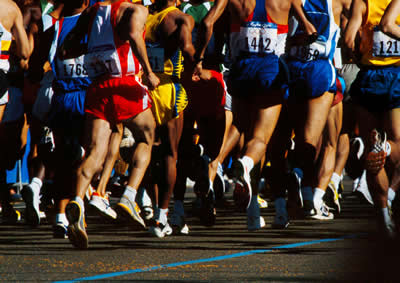By T.J. Murphy in Active.com
CrossFit Endurance coach and 100-mile trail run fanatic, Brian MacKenzie of Costa Mesa, California, scrawled a simple looking workout set on a whiteboard in his home gym, then spent five minutes teaching me proper rowing technique. I was in need of a workout to help me retain fitness while I rehabbed a foot injury, so he directed me to a rowing machine-commonly referred to as an ergometer or "erg." Then I endured one of the most challenging cross-training workouts of my life-for exactly 12 minutes.
"Rowing is an invaluable tool for runners," MacKenzie said. "When you learn how to do it right it lights up weaknesses you didn't know you had. It helps runners and cyclists find power in muscles they hadn't used before."
MacKenzie points out that rowing is a potent weapon in an endurance athlete's cross-training arsenal, or as a replacement for running when injuries surface. "It's no joke," he said. "It's some serious, lung-searing stuff. When an athlete is dealing with a foot or Achilles tendon problem, I've never found issues in replacing running with work on the ergometer."
Lori Gallon is evangelistic about the magic that rowing can bestow upon an injured runner. A registered nurse who moonlights as a personal trainer at R.A.W. Training in Wildwood, Pennsylvania, Gallon said that rowing salvaged her dream of running the Boston Marathon.
In 2009, at 42, she qualified for Boston, but two weeks into a 15-week training plan targeting the 2010 event, she developed a stress fracture in her fibula. Per doctors' orders, she was not allowed to run or jump for eight to 10 weeks.
"I couldn't believe I had made it that far and I didn't know if I'd get another shot to qualify for Boston," she said. "I talked to other trainers at my gym and decided to use rowing to train for the race. I had nothing to lose."
In place of key running workouts, Gallon used indoor rowing. "It's all about proper technique," she said. "If you don't do it right it's not going to work."
Gallon's doctor cleared her to run again two weeks out from Boston. "I did one five-miler and one 10-miler. Everything else I had done in the buildup had been rowing and doing CrossFit workouts." Gallon finished the marathon in 4:20:26.
While running and rowing are similar in cardiovascular benefits, they differ in the muscular workout they deliver. Erin Cafaro, a 2008 Olympic gold medalist and member of the U.S. rowing squad, said that rowing punishes the body in different ways. "In one continuous motion rowing works legs, core, back and arms," she said. "It's a full-body workout."
MacKenzie added that one of the chief benefits rowing offers runners is improved posture. "Runners typically have terrible posture, leading to bad form, leading to beating the hell out of yourself," he said. Proper rowing, MacKenzie believes, helps runners develop robust midline stability to help shift running from smaller, weaker muscles such as hip flexors to more powerful muscles in the hips.
Properly performed rowing gives a runner a solid blast of cardio work, works the abs, core and lower back, and even develops flexibility in the hamstrings and calves.
Where should you start? Don't make the mistake most runners do when they first hit the rowing machine and yank away-not only will you miss out on the primary benefits rowing has to offer, but you also might make things worse. Follow Erin Cafaro's guide (on page 3) to developing proper technique.
How to Supplement a Running or Multisport Program With Rowing
Will Kirousis is the co-director of Tri-Hard Endurance Sports Coaching and is a USA Triathlon-certified coach and strength specialist in Leominster, Massachusetts Kirousis explains why and how to adopt rowing into an overall training program.
What benefits does rowing offer runners and triathletes?
Rowing machines allow runners to do a non-impact form of endurance training. Don't get me wrong, if you want to be a better runner, your training should focus on running. However, cross-training during noncompetitive periods in the year and during recovery blocks throughout the season helps runners stay injury free and mentally fresh. Those are the key benefits of rowing for runners.
Any tips for runners and triathletes taking up rowing as cross-training?
Strongly resist the urge to become a rowing specialist. This is especially true for triathletes, who tend to want to mimic the training done in the specific sub sports of their discipline. For example, very often triathletes fall into the trap of training like Masters swimmers, road cyclists and runners rather than training like a triathlete. The same intensity and inquisitiveness that leads to those miss-steps can also lead a motivated runner or triathlete to use the erg as if he is a crew specialist. This is counterproductive because it can hurt recovery. If you're really trying to improve on the erg, it's likely your training load will increase on the erg and will cut into your recovery, leading to decreased volumes of sport-specific training. Both problems reduce sport-specific performance.
High-Intensity Workouts to Aid the Injured Runner
Beating back an injury but want to sustain your running fitness? Shane Farmer, a former member of the University of San Diego rowing team and now a CrossFit Invictus coach, has several basic rowing workout suggestions for injured runners who need to replace track workouts. Be sure to get the all-clear from your doctor before jumping in.
500-meter Repeats
4x500 meters, 2 minute rest between each. Similar in nature to the feel of running 800-meter intervals at a moderately high intensity. Use the memory function on the rowing computer to log your workout.
Long Sprints
8x45 seconds hard. 15-second easy recovery between each hard interval. "Good old fashioned, short, high intensity interval training," Farmer said.
The Time Ladder
Ten minutes nonstop: four minutes, three minutes, two minutes, one minute, building up intensity in each transition with no rest in between. The four minutes should be at a relative base tempo with the one-minute intervals at high intensity. Be sure to have enough in the tank to make moves at each time transition.
The Stroke Ladder
4x5 minutes. Each five-minute session is broken into five, one-minute segments with a focus on the number of strokes you take per minute (s/m), which the erg computer tallies in real time. First minute: 18 s/m, second minute: 22 s/m, third: 26 s/m, fourth: 22 s/m, fifth, 26 s/m.
"Again, there will be no rest," Farmer says. "The workout should last for 20 minutes total without stopping." Use the time spent at 18 s/m to recover. Each jump up in stroke rate will come with an increase in intensity and vice versa. "This is a really good tempo piece that teaches people how to control their output and rate of recovery, which are two very crucial aspects of rowing."
Rowing Technique: The Essentials
Proper grip. Curl your fingers around the handle and keep the wrist joints cocked slightly.
Secure the feet. Insert your feet into the footrests and adjust the toe strap so that it crosses over the top shoelace. Pull the straps snug around your feet.
From "The catch" or start position into the early drive. Keep your shins vertical and the muscles tight, pulling your belly button up and in, and make a point to retain good posture. Slant the upper body forward, extending powerfully from the hips. Avoid hunching your shoulders. From this position, begin the "drive" phase by employing your leg muscles with a powerful push off. Retain the forward tilt of your upper body for the first half of the drive phase-approximately a foot of travel as the seat slides backward on the rail.
The drive. Push through with your legs, and in a continuous motion, begin to use your back and abs as a lever, transferring the workload to a combination of your legs and the muscles surrounding your core. Resist the temptation to begin pulling with your arms until you've completely channeled the power from your abdominal and back muscles. With legs fully extended, begin using your arms to pull and finish the stroke. Keep the muscles of the core-the midline stability muscles-activated and tight.
The finish into the recovery. Upon completing the drive and pulling the handle to a point just in front of your upper abdominals, you will transition into the recovery phase. While keeping a tight core, smoothly return to the starting position at half the speed used in the drive. Use this time to allow the muscles to recover. Reverse the sequence of the chain of movements-arms, back and core, and finally allow the legs to return to the spring-like position of the catch.
| 


 When you send in your race results, please include the following: Name of race, date of race, your age, time, any age group award. Thanks
When you send in your race results, please include the following: Name of race, date of race, your age, time, any age group award. Thanks
 If you take pictures at club events or already have pictures of recent club events/races, we have set up a Picasa web account for club members to use. This will enable the Club to keep an archive of pictures in one location which will be viewable by everyone. If you are interested in uploading pictures to our site, contact me and I will give you the login information. Click
If you take pictures at club events or already have pictures of recent club events/races, we have set up a Picasa web account for club members to use. This will enable the Club to keep an archive of pictures in one location which will be viewable by everyone. If you are interested in uploading pictures to our site, contact me and I will give you the login information. Click 